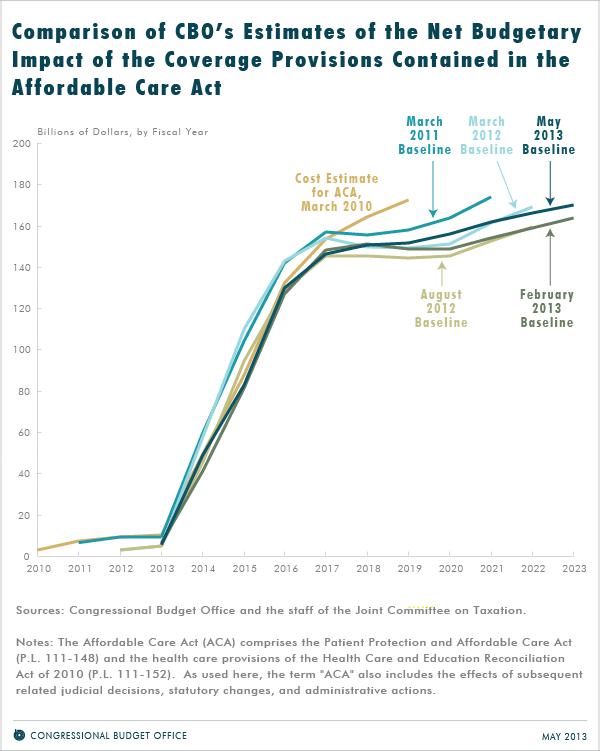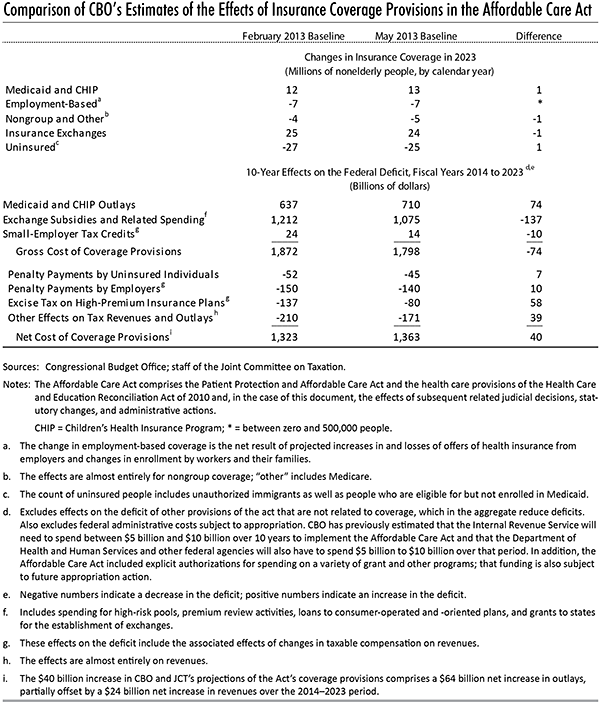Today’s report containing CBO’s latest budget projections includes updated estimates of the impact of the insurance coverage provisions of the Affordable Care Act (ACA). In that report, the updated estimates are included in broad categories of outlays and revenues, and the largest changes to the estimates since February 2013 are discussed on pages 5 to 7. This blog post describes in more detail our revised expectations about sources of people’s insurance coverage and the net budgetary impact of those revisions. As in the past, the projections of the effects of the ACA’s insurance coverage provisions on the federal budget were prepared by CBO in conjunction with staff of the Joint Committee on Taxation (JCT).
The Estimated Budgetary Impact of the ACA’s Coverage Provisions Has Changed Little on a Year-by-Year Basis Since March 2010
When estimates are compared on a year-by-year basis, CBO and JCT’s estimate of the net budgetary impact of the ACA’s insurance coverage provisions has changed little since February 2013 and, indeed, has changed little since the legislation was being considered in March 2010. In March 2010, CBO and JCT projected that the provisions of the ACA related to health insurance coverage would cost the federal government $759 billion during fiscal years 2014 through 2019 (which was the last year in the 10-year budget window being used at that time). The newest projections indicate that those provisions will cost $710 billion over that same period. As shown in the figure below, the intervening projections of the cost of the ACA’s coverage provisions for those years have all been close to those figures on a year-by-year basis; of course, the 10-year totals have changed as the time frame for the estimates has shifted.
Those amounts do not reflect the total budgetary impact of the ACA. That legislation includes many other provisions that, on net, will reduce budget deficits. Taking the coverage provisions and other provisions together, CBO and JCT have estimated that the ACA will reduce deficits over the next 10 years and in the subsequent decade. (We have not updated our estimate of the total budgetary impact of the ACA since last summer; for that most recent estimate, see Letter to the Honorable John Boehner providing an estimate for H.R. 6079, the Repeal of Obamacare Act.)

The Estimated Budgetary Impact of the ACA’s Coverage Provisions Has Risen A Little Since February 2013
CBO and JCT’s current projection of the budgetary impact of the ACA’s coverage provisions is $1,363 billion over the 2014–2023 period. That amount represents an increase of $40 billion from the February 2013 estimate of $1,323 billion, as shown in the table below. Although the gross cost of those provisions is now projected to be $74 billion less over the 10-year period, various payments to the government and other savings related to those provisions are now also estimated to be less—by $114 billion; the combination of those two effects has boosted the projected net cost of the coverage provisions.
The new estimate reflects recent regulatory actions along with certain updated data and changes in estimating methodology since the February 2013 report was issued. The most important changes include the following:
Gross Costs
- CBO and JCT now project that the ACA will increase the number of people enrolled in Medicaid and the Children’s Health Insurance Program (CHIP) by more than estimated previously—for example, by 13 million in 2023 rather than 12 million. That increase in projected enrollment stems primarily from our expectation that more potentially newly eligible Medicaid beneficiaries will be residents of states that fully extend Medicaid coverage under the ACA (encompassing people with income up to 138 percent of the federal poverty level). Because of the higher projected enrollment, the costs for Medicaid and CHIP are now expected to be $74 billion greater over the 2014–2023 period than previously estimated.
- CBO and JCT now project that fewer people will be enrolled in health insurance exchanges than estimated previously—for example, 24 million in 2023 rather than 25 million. That reduction in projected enrollment is the net effect of several factors, the largest of which is the estimated increase in the share of the potentially eligible population that will reside in states that fully extend Medicaid coverage. Because of the lower projected enrollment in the exchanges and some small modeling changes, the costs for exchange subsidies and related spending are now expected to be $137 billion lower over the 2014–2023 period than previously estimated. In addition, we adjusted our estimates of the share of exchange subsidies that reduces recipients’ tax liability, reducing the share recorded as a revenue loss and increasing the share recorded as outlays. As a result of that shift and other factors, our estimate of the revenues lost through exchange subsidies over the 10-year period is now $138 billion lower, and our estimate of outlays for exchange subsidies and related spending is now less than $1 billion higher, than in the February estimate.
- CBO and JCT also now project that the cost of small business tax credits over the 2014–2023 period will be $10 billion lower than previously estimated, reflecting preliminary tax data showing that small businesses continue to be slow in taking advantage of those credits.
Payments to the Government and Other Savings
- Proposed regulations recently issued by the Department of Health and Human Services and the Department of the Treasury expanded the number of people who will be exempt from paying a penalty for being uninsured relative to our previous expectations. CBO and JCT now expect that, as a result of those regulations, between 500,000 and 1 million fewer people will obtain health insurance coverage each year. In our current projections for 2023, the ACA reduces the number of people without health insurance by 25 million, leaving 31 million uninsured (compared with 30 million in our February estimate). Also as a result of those regulations, penalties collected from individuals for being uninsured are now projected to be $7 billion less over the 2014–2023 period than previously estimated.
- In the latest projections, CBO and JCT incorporated new data on the health insurance premiums paid by employers. As a result, we now expect fewer employment-based plans to be subject to the excise tax on high-premium insurance plans and, consequently, have reduced our estimate of revenues from that tax by $58 billion over the 10-year period.
- In our health insurance simulation model, refinements in how households’ marginal tax rates are estimated slightly increased the number of the people expected to have employment-based coverage (although the projected net decline in the number of people with such coverage owing to the ACA still rounds to 7 million in 2023). That slight increase in projected employment-based coverage increases the estimated loss of government revenues from the exclusion from taxation of employers’ payments of health insurance premiums for their employees. That change, along with other small modeling changes, raised the estimated net cost of the coverage provisions by $39 billion over the 2014–2023 period (shown in the line labeled “Other Effects on Tax Revenues and Outlays”) compared with the February 2013 estimate.
- CBO and JCT reduced the estimated amount of penalty payments by employers by $10 billion over the 2014–2023 period. That revision stems from the slight increase in projected employment-based coverage and a regulatory change that reduces the extent of employers’ liability for penalties.

Jessica Banthin is Senior Advisor in CBO's Health, Retirement, and Long-Term Analysis Division. Sarah Masi is an analyst in CBO's Budget Analysis Division.

